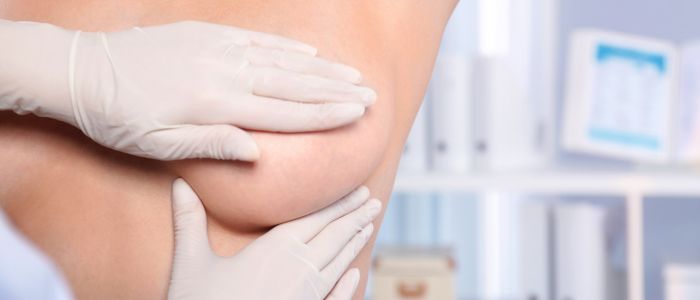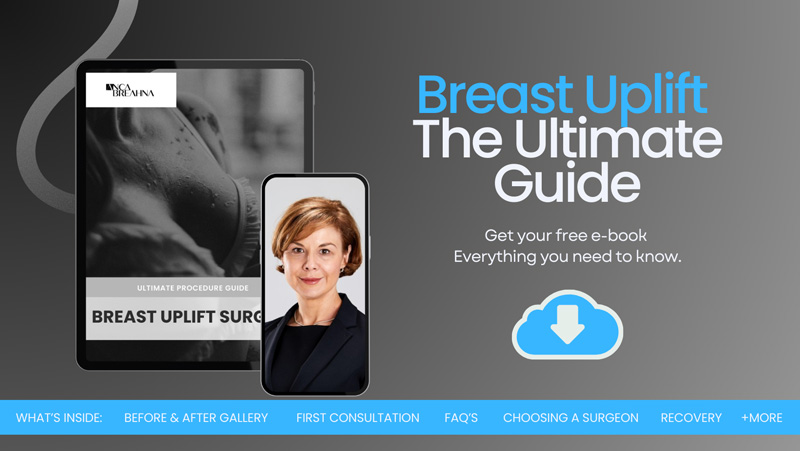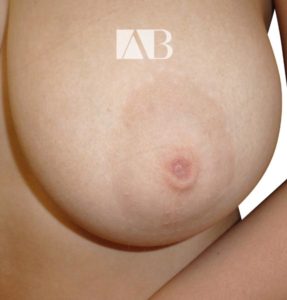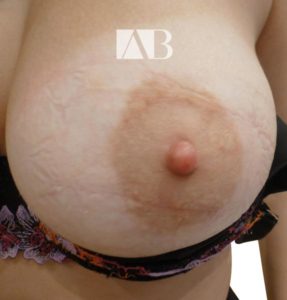
Table of Contents
- Want to find out how to fix Inverted Nipples?
- Download Anca Breahna’s Breast Uplift Guide
- How common are Inverted Nipples?
- What causes Inverted Nipples or Flat Nipples?
- Insights into Surgical Procedures
- A Guide on Post-Operative Care
- Comparison of Surgical vs Non-Surgical Treatments for Inverted Nipples
- Psychological Impact of Nipple Correction
- FAQs about How to Fix Inverted Nipples
- Other Nipple Concerns
- Consultation for Nipple Concerns
- Niplette – Non Surgical Nipple Treatments
- Inverted Nipple Surgery Results Before and After
- Further Reading about Inverted Nipple Correction
Want to find out how to fix Inverted Nipples?
Inverted nipples are usually completely harmless and typically appear from birth. Other causes include breastfeeding (this may damage the milk ducts and cause them to retract, pulling the nipples inward) or surgery (scar tissue from previous surgeries may lead to inversion).
When an inverted nipple becomes apparent later in life, it could be due to an underlying medical concern. An inverted nipple is recognised by its having a sunken appearance, as opposed to the nipple protruding outward from the surface of the skin.
You may wish to have a procedure to correct an inverted nipple when it causes personal embarrassment or is obvious through clothing.
Download Anca Breahna’s Breast Uplift Guide

How common are Inverted Nipples?
Inverted nipples are actually fairly common in both women and men and sometimes can be present only on one side. The severity of inverted nipples can vary and it is defined by a three-level grading system. Mild cases of inverted nipples (nipples are either flat or minimally inverted ) can sometimes be treated without surgery using certain suction devices which can gently stretch and lengthen the milk ducts. Grade 2 and 3 of inverted nipples usually require surgical correction to release the tight milk ducts and achieve a more pleasing nipple appearance.
What causes Inverted Nipples or Flat Nipples?
Inverted nipples, also known as retracted nipples, do not protrude from the breast. Instead, they lie flat, or point inward. They are usually present from birth as they are mainly caused by an underdeveloped nipple base or milk ducts, which will have occurred in the womb. Inverted nipples can affect both men and women, and may affect either one or both of the breasts.
In many cases, inverted nipples will protrude when manually or sexually stimulated, or when exposed to cold temperatures; however, it’s not uncommon for people to find they stay inverted permanently. When inverted nipples develop as a person gets older, it’s often due to an underlying medical condition which will need to be investigated. This may include: trauma, tissue inflammation, breastfeeding, tumour or infection.
Insights into Surgical Procedures
Nipple correction surgery, particularly for inverted nipples, involves several nuanced techniques designed to preserve nipple functionality and aesthetics. The most common procedure is the minimally invasive approach where small incisions are made at the base of the nipple. Through these incisions, fibrous bands that cause the nipple inversion are released, allowing the nipple to protrude normally.
One of the key techniques used is the “purse-string” method. In this technique, a small suture is placed around the base of the nipple, carefully tightened to ensure the nipple stays in an everted position. This method is favoured for its ability to adjust tension and provide a natural-looking result.
Another technique involves the use of dermal flaps or fat grafting to add volume under the nipple, supporting its new position. Anca may opt for this technique when there is a significant shortage of supportive tissue beneath the nipple.
A Guide on Post-Operative Care
Post-operative care is important for the success of nipple correction surgery. Immediately following the procedure, you can expect mild swelling and bruising, which generally subsides within a few weeks. It’s important to follow Anca’s instructions carefully, which will likely include:
- Wound Care: Keeping the surgical area clean and dry is paramount. Dressings, if applied, should be kept intact until the follow-up appointment.
- Activity Restrictions: Patients are typically advised to avoid strenuous activities and heavy lifting for a specific period, usually around 2-3 weeks, to prevent any strain on the surgical site.
- Pain Management: Mild pain or discomfort can be managed with prescribed or over-the-counter pain relievers as recommended by the surgeon.
- Monitoring: You should watch for signs of infection or any changes in the nipple’s appearance and report these to your medical team immediately.
Long-term care involves monitoring the surgical results and attending regular follow-up appointments. Maintaining a relationship with the surgical team ensures any complications are addressed promptly and results are optimised.
Comparison of Surgical vs Non-Surgical Treatments for Inverted Nipples
For many patients, deciding between surgical and non-surgical treatments for inverted nipples depends on several factors, including the severity of the inversion, the desired outcome, and personal health.
- Surgical Treatments offer a permanent correction for inverted nipples. The benefits include a high success rate and a one-time procedure, making it an attractive option for those looking for a definitive solution. However, the downsides include the risks associated with surgery such as infection, changes in nipple sensation, or dissatisfaction with the aesthetic results.
- Non-Surgical Treatments such as suction devices or nipple shields are less invasive and can be effective for mild cases of nipple inversion. These methods involve using the device to gently draw the nipple out over a period of time. The advantages are minimal risk and no recovery time. However, results are not permanent and these methods may not be effective for more severe cases.
The choice between these options should be made based on a thorough consultation with Anca, considering your specific circumstances and goals.
Psychological Impact of Nipple Correction
The psychological impact of having inverted nipples can be significant, affecting self-esteem and body image. Many women may feel a sense of abnormality or embarrassment, which can lead to avoidance of intimate situations or certain types of clothing.
Undergoing nipple correction surgery can have a profound positive effect on mental and emotional well-being. Patients often report improved self-confidence and comfort with their bodies post-surgery. The ability to wear different styles of clothing without worry, and engage in intimate relationships without self-consciousness, can be liberating.
It’s important for potential patients to discuss their feelings and expectations with Anca before deciding on surgery. Psychological support, either through counselling or support groups, can also be beneficial both before and after the procedure, helping you manage your expectations and emotions associated with the change.
FAQs about How to Fix Inverted Nipples

What is the typical recovery time for nipple correction surgery?
Recovery times can vary, but most patients are able to return to normal activities within a week, with complete healing taking a few weeks.
Can nipple correction surgery affect my ability to breastfeed?
In most cases, surgery aims to preserve milk ducts, but there’s a potential risk of affecting breastfeeding capabilities. It’s important to discuss these risks with Anca during your consultation.
Are there any age restrictions for undergoing nipple correction surgery?
Nipple correction surgery is generally recommended for women who have completed their breast development, which typically concludes around age 18.
How long do the results of nipple correction surgery last?
Surgical correction of inverted nipples is generally permanent, although factors like pregnancy and significant hormonal changes can potentially alter the results.
What should I look for when choosing a surgeon for nipple correction surgery?
It’s important to select a certified plastic surgeon with experience in nipple correction surgeries. Reviewing before-and-after photos of their previous work and reading patient reviews can also be helpful.
Will I need to take any special medications after the surgery?
Post-surgery, you may be prescribed pain relievers and possibly antibiotics to prevent infection. Anca will provide specific instructions based on your individual case and needs.
Medical References for Inverted Nipple Correction
- Flat and Inverted Nipples: https://my.clevelandclinic.org/health/diseases/25118-flat-and-inverted-nipples
- Surgical Correction of Inverted Nipples: https://pubmed.ncbi.nlm.nih.gov/10654685/
Other Nipple Concerns
Large nipples/ areola, are other commonly treated nipple concerns at Chester Cosmetic Surgery. Enlarged nipples and / or areola often occur naturally. They are most likely to cause an aesthetic concern, appearing bigger and more prominent than one would like. For some, the nipples and areola may change size and shape if the breasts also change size; such as during pregnancy, when breastfeeding, during hormonal fluctuations or from having gained weight. People affected by large nipples can often feel self-conscious of their appearance, especially if the nipples tend to be quite protruding and are visible through clothing. This aspect can lead to sore nipples if they then rub regularly against fabric.
Consultation for Nipple Concerns
Treating inverted nipples/ nipple concerns at Chester Cosmetic Surgery will require an initial consultation. In order to recommend the right approach we’ll need to identify the possible cause. Treatment options include inverted nipple correction or nipple and areola reduction, where Anca will perform the most suitable techniques to achieve your goal.
Niplette – Non Surgical Nipple Treatments
Always consider using alternatives like Niplette – non surgical Nipple Correction – before having surgery.
Inverted Nipple Surgery Results Before and After
Further Reading about Inverted Nipple Correction
- Read Anca’s Procedure Page about Inverted Nipple Correction Surgery








